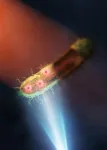(Press-News.org) A team at the University of Tokyo have constructed an improved mid-infrared microscope, enabling them to see the structures inside living bacteria at the nanometer scale. Mid-infrared microscopy is typically limited by its low resolution, especially when compared to other microscopy techniques. This latest development produced images at 120 nanometers, which the researchers say is a thirtyfold improvement on the resolution of typical mid-infrared microscopes. Being able to view samples more clearly at this smaller scale can aid multiple fields of research, including into infectious diseases, and opens the way for developing even more accurate mid-infrared-based imaging in the future.
The microscopic realm is where viruses, proteins and molecules dwell. Thanks to modern microscopes, we can venture down to see the inner workings of our very own cells. But even these impressive tools have limitations. For example, super-resolution fluorescent microscopes require specimens to be labeled with fluorescence. This can sometimes be toxic to samples and extended light exposure while viewing can bleach samples, meaning they are no longer useful. Electron microscopes can also provide very impressive details, but samples must be placed in a vacuum, so live samples cannot be studied.
By comparison, mid-infrared microscopy can provide both chemical and structural information about live cells, without needing to color or damage them. However, its use has been limited in biological research because of its comparatively low resolution capability. While super-resolution fluorescent microscopy can narrow down images to tens of nanometers (1 nanometer being one-millionth of a millimeter), mid-infrared microscopy can typically only achieve around 3 microns (1 micron being one-thousandth of a millimeter).
However, in a new breakthrough, researchers at the University of Tokyo have attained a higher resolution of mid-infrared microscopy than ever before. “We achieved a spatial resolution of 120 nanometers, that is, 0.12 microns. This amazing resolution is roughly 30 times better than that of conventional mid-infrared microscopy,” explained Professor Takuro Ideguchi from the Institute for Photon Science and Technology at the University of Tokyo.
The team used a “synthetic aperture,” a technique combining several images taken from different illuminated angles to create a clearer overall picture. Typically, a sample is sandwiched between two lenses. The lenses, however, inadvertently absorb some of the mid-infrared light. They solved this issue by placing a sample, bacteria (E. coli and Rhodococcus jostii RHA1 were used), on a silicon plate which reflected visible light and transmitted infrared light. This allowed the researchers to use a single lens, enabling them to better illuminate the sample with the mid-infrared light and get a more detailed image.
“We were surprised at how clearly we could observe the intracellular structures of bacteria. The high spatial resolution of our microscope could allow us to study, for example, antimicrobial resistance, which is a worldwide issue,” said Ideguchi. “We believe we can continue to improve the technique in various directions. If we use a better lens and a shorter wavelength of visible light, the spatial resolution could even be below 100 nanometers. With superior clarity, we would like to study various cell samples to tackle fundamental and applied biomedical problems.”
#####
Paper Title
Miu Tamamitsu, Keiichiro Toda, Masato Fukushima, Venkata Ramaiah Badarla, Hiroyuki Shimada, Sadao Ota, Kuniaki Konishi, and Takuro Ideguchi. Mid-infrared wide-field nanoscopy. Nature Photonics. April 17th 2024. DOI: 10.1038/s41566-024-01423-0
Useful Links
Department of Physics: https://www.phys.s.u-tokyo.ac.jp/en/
Graduate School of Science: https://www.s.u-tokyo.ac.jp/en/index.html
Ideguchi Group: https://takuroideguchi.jimdo.com/
[Press releases] See live cells with 7 times greater sensitivity using new microscopy technique
[Press releases] Giant leap for molecular measurements
[Press releases] Unprecedented 3D images of live cells plus details of molecules inside
[Press releases] A laser, a crystal and molecular structures
[Press releases] Researchers give standard light microscopes an upgrade to see inside cells
Funding:
This research was supported by the Japan Society for the Promotion of Science (20H00125, 23H00273), JST PRESTO (JPMJPR17G2), Precise Measurement Technology Promotion Foundation, Research Foundation for Opto-Science and Technology, Nakatani Foundation, and UTEC-UTokyo FSI Research Grant. Fabrication of the custom-made resolution test chart was performed using the apparatus at the Takeda Clean Room of d.lab at The University of Tokyo.
Competing interests
M.T., K.T., and T.I. are inventors of patents related to MIP-QPI. [mid-infrared photothermal quantitative phase imaging]
Research Contact:
Professor Takuro Ideguchi
Institute for Photon Science and Technology,
The University of Tokyo, Tokyo 113-0033, Japan
Tel.: +81-3-5841-1026
Email: ideguchi@ipst.s.u-tokyo.ac.jp
Press contact:
Mrs. Nicola Burghall (she/her)
Public Relations Group, The University of Tokyo,
7-3-1 Hongo, Bunkyo-ku, Tokyo 113-8654, Japan
press-releases.adm@gs.mail.u-tokyo.ac.jp
About the University of Tokyo
The University of Tokyo is Japan’s leading university and one of the world’s top research universities. The vast research output of some 6,000 researchers is published in the world’s top journals across the arts and sciences. Our vibrant student body of around 15,000 undergraduate and 15,000 graduate students includes over 4,000 international students. Find out more at www.u-tokyo.ac.jp/en/ or follow us on X at @UTokyo_News_en.
END
A better view with new mid-infrared nanoscopy
Chemical images taken of insides of bacteria 30 times clearer than those from conventional mid-infrared microscopes
2024-04-17
ELSE PRESS RELEASES FROM THIS DATE:
New study uncovers why boys born to mothers with HIV are at greater risk of health problems and death in infancy
2024-04-17
Researchers have found that children of women with HIV infection have an increased risk of immune abnormalities following exposure to maternal HIV viraemia, immune dysfunction, and co-infections during pregnancy.
The study, led by Dr Ceri Evans while at Queen Mary University of London, compared clinical outcomes between infants who were HIV-exposed and HIV-unexposed in the Sanitation Hygiene Infant Nutrition Efficacy (SHINE) trial in rural Zimbabwe. Despite high coverage of maternal antiretroviral therapy (ART) and uptake of exclusive breastfeeding, mortality in infants exposed to HIV was 41% higher than in infants not exposed to HIV. Infants who survived and remained HIV-free ...
Interspecies competition led to even more forms of ancient human – defying evolutionary trends in vertebrates
2024-04-17
Competition between species played a major role in the rise and fall of hominins – and produced a “bizarre” evolutionary pattern for the Homo lineage – according to a new University of Cambridge study that revises the start and end dates for many of our early ancestors.
Conventionally, climate is held responsible for the emergence and extinction of hominin species. In most vertebrates, however, interspecies competition is known to play an important role.
Now, research shows for the first time that competition was fundamental to “speciation” – the rate at which new species emerge ...
First new analysis in three decades identifies which treatments for the long-term effects of malnutrition could help reduce mortality and poor health outcomes for children
2024-04-17
A comparison of treatments for malnutrition enteropathy, caused by severe acute malnutrition (SAM), has found evidence supporting the use of treatments to enhance the healing of mucosal membranes and reduce inflammation in the gut to improve the outcomes of children affected by long-team health consequences of a period of malnutrition.
The Therapeutic Approaches to Malnutrition Enteropathy (TAME), led by researchers from Queen Mary University of London, evaluated four interventions for malnutrition enteropathy in a multi-centre phase ...
AI speeds up drug design for Parkinson’s by ten-fold
2024-04-17
Researchers have used artificial intelligence techniques to massively accelerate the search for Parkinson’s disease treatments.
The researchers, from the University of Cambridge, designed and used an AI-based strategy to identify compounds that block the clumping, or aggregation, of alpha-synuclein, the protein that characterises Parkinson’s.
The team used machine learning techniques to quickly screen a chemical library containing millions of entries, and identified five highly potent compounds for further investigation.
Parkinson’s affects more than six million people worldwide, with that number projected to triple by 2040. ...
Older adults with diabetes experienced functional decline during the COVID-19 pandemic
2024-04-17
Toronto, ON —Researchers found that approximately 1 in 5 older Canadian adults with diabetes and no pre-pandemic functional limitations developed functional limitations for the first time during the COVID-19 pandemic. Functional limitations refer to difficulties with basic mobility-related tasks, such as walking two to three blocks, standing up from a chair, or climbing stairs. In comparison, only one in eight of their peers without diabetes developed functional limitations during the ...
How soil microbes survive in harsh desert environments
2024-04-17
Prolonged droughts followed by sudden bursts of rainfall – how do desert soil bacteria manage to survive such harsh conditions? This long-debated question has now been answered by an ERC project led by microbiologist Dagmar Woebken from the Centre for Microbiology and Environmental Systems Science (CeMESS) at the University of Vienna. The study reveals that desert soil bacteria are highly adapted to survive the rapid environmental changes experienced with each rainfall event. These findings were recently published in the prestigious ...
Toronto researchers uncover human DNA repair by nuclear metamorphosis
2024-04-17
Researchers at the University of Toronto have discovered a DNA repair mechanism that advances understanding of how human cells stay healthy, and which could lead to new treatments for cancer and premature aging.
The study, published in the journal Nature Structural and Molecular Biology, also sheds light on the mechanism of action of some existing chemotherapy drugs.
“We think this research solves the mystery of how DNA double-strand breaks and the nuclear envelope connect for ...
Fluctuating coffee prices put mental pressure on Vietnamese farmers
2024-04-17
While your invigorating morning coffee may become cheaper when there are large fluctuations in the world market price, they are a major additional psychological burden for the farmers who grow the coffee.
This is documented in a new international study on the effect of income uncertainty on the mental health of Vietnamese coffee farmers.
"Our results suggest that not only poverty, but also the risk of poverty caused by fluctuating prices has a significant additional negative effect on the mental well-being of farmers in low-income countries," says Finn ...
Silver-based micromotors that eliminate bacteria moving freely in aqueous media
2024-04-17
In ancient Greece, over 3000 years ago, wise men used silver salts to prevent wounds from becoming infected. These salts continued to be used until Alexander Fleming discovered the first antibiotic "just" 100 years ago. The use of antibiotics represented a major breakthrough in the treatment of infectious diseases, but resistance soon began to emerge. Bacteria, which have been on the planet longer than us, have found ways to overcome different antibiotics, and today antibiotic resistance is a major global health problem.
In times when everything evolves ...
New research shows urgency to act on Nigeria’s trans fat elimination policy
2024-04-17
Significantly reducing trans fat levels in the Nigerian food supply could prevent approximately 10,000 heart disease deaths and save 90 million USD (12 billion Naira, ₦) in healthcare costs over a decade. New findings by The George Institute for Global Health on the health and economic benefits of enacting the country’s trans fat elimination policy were published today in BMJ Global Health.
In 2023, Nigeria followed South Africa as only the second African country to adopt a best practice trans fat ...
LAST 30 PRESS RELEASES:
Injectable breast ‘implant’ offers alternative to traditional surgeries
Neuroscientists devise formulas to measure multilingualism
New prostate cancer trial seeks to reduce toxicity without sacrificing efficacy
Geometry shapes life
A CRISPR screen reveals many previously unrecognized genes required for brain development and a new neurodevelopmental disorder
Hot flush treatment has anti-breast cancer activity, study finds
Securing AI systems against growing cybersecurity threats
Longest observation of an active solar region
Why nail-biting, procrastination and other self-sabotaging behaviors are rooted in survival instincts
Regional variations in mechanical properties of porcine leptomeninges
Artificial empathy in therapy and healthcare: advancements in interpersonal interaction technologies
Why some brains switch gears more efficiently than others
UVA’s Jundong Li wins ICDM’S 2025 Tao Li Award for data mining, machine learning
UVA’s low-power, high-performance computer power player Mircea Stan earns National Academy of Inventors fellowship
Not playing by the rules: USU researcher explores filamentous algae dynamics in rivers
Do our body clocks influence our risk of dementia?
Anthropologists offer new evidence of bipedalism in long-debated fossil discovery
Safer receipt paper from wood
Dosage-sensitive genes suggest no whole-genome duplications in ancestral angiosperm
First ancient human herpesvirus genomes document their deep history with humans
Why Some Bacteria Survive Antibiotics and How to Stop Them - New study reveals that bacteria can survive antibiotic treatment through two fundamentally different “shutdown modes”
UCLA study links scar healing to dangerous placenta condition
CHANGE-seq-BE finds off-target changes in the genome from base editors
The Journal of Nuclear Medicine Ahead-of-Print Tip Sheet: January 2, 2026
Delayed or absent first dose of measles, mumps, and rubella vaccination
Trends in US preterm birth rates by household income and race and ethnicity
Study identifies potential biomarker linked to progression and brain inflammation in multiple sclerosis
Many mothers in Norway do not show up for postnatal check-ups
Researchers want to find out why quick clay is so unstable
Superradiant spins show teamwork at the quantum scale
[Press-News.org] A better view with new mid-infrared nanoscopyChemical images taken of insides of bacteria 30 times clearer than those from conventional mid-infrared microscopes






